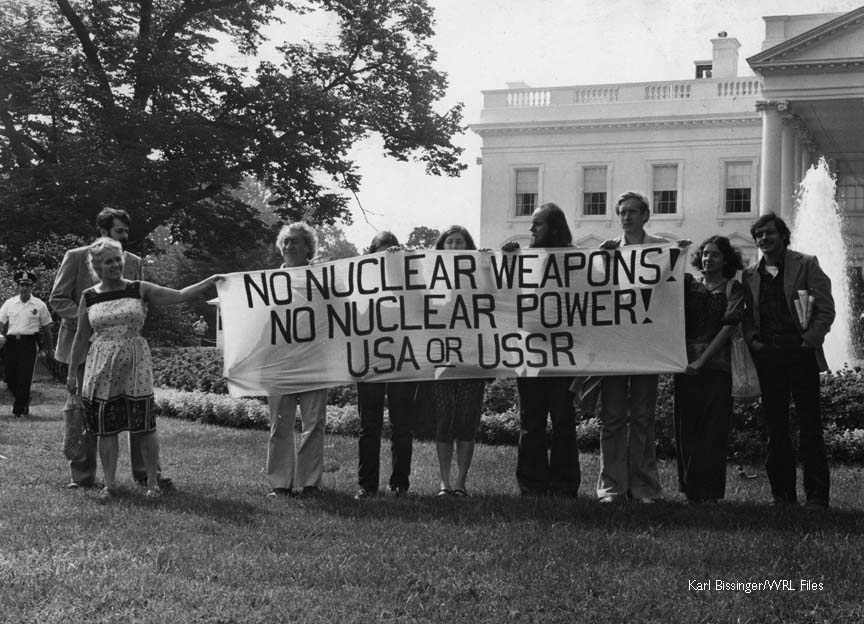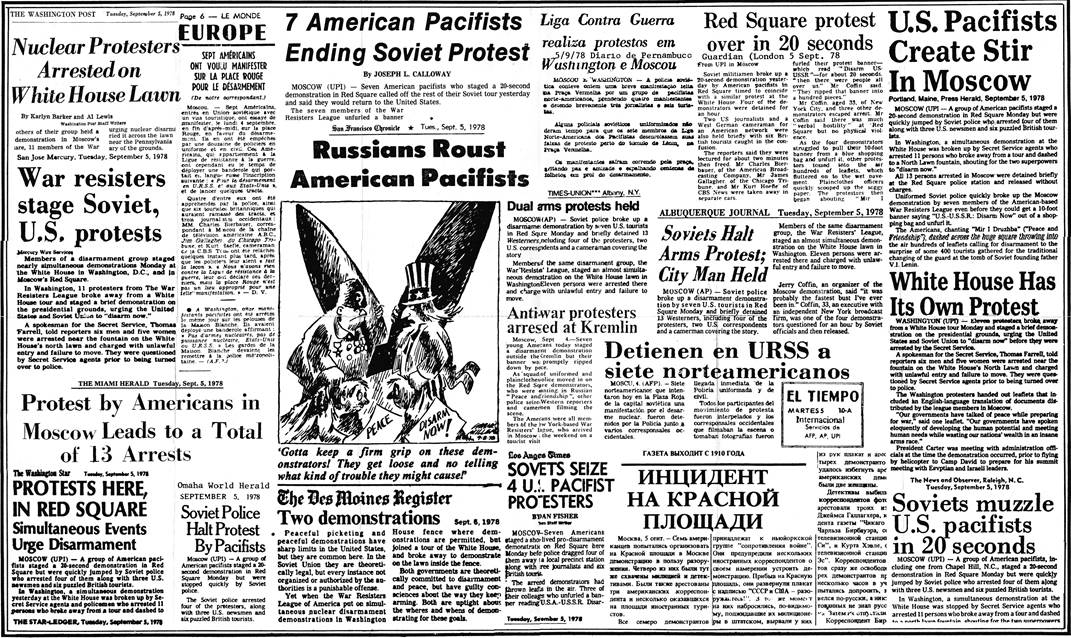
On the White House lawn (l to r): Van Zwisohn, Grace Paley, Ralph DiGia, Cathy Carlson, Gail Bederman, Warren Hoskins, Ed Hedemann, Karen Malpede and Glenn Pontier. Also arrested and not pictured are Linnea Capps and photographer Karl Bissinger. Photo: Karl Bissinger/WRL Files
On September 4, 1978 WRL members launched simultaneous disarmament demonstrations on the White House Lawn in Washington, DC and in Red Square in Moscow, USSR. This creative—and maybe rash—action was the brainchild of WRL staffers, notably Jerry Coffin and Lynne Shatzkin Coffin.
I was honored to be tasked to lead the Washington contingent. (See Steve Sumerford’s blog in this series for an account of action in Red Square.)
WRL regulars, including me, comprised the group of 11 that gathered on the White House Lawn: Gail Bederman, Karl Bissinger, Linnea Capps, Cathy Carson, Ralph DiGia, Ed Hedemann, Warren Hoskins, Karen Malpede, and Grace Paley. To that mix, I added a journalist friend and draft resister Glenn Pontier and we were immeasurably aided by friends Lin Geary and Mike Moran.
We also had lots of help from a savvy press guy who got us into the National Press Club building to slip our press release under the door of the major wire services and national press. Grace was interviewed by All Things Considered on NPR, and we had generally favorable national coverage.
Mike and I made a dry run in advance of the demonstration and found that we were not searched going through the public tours of the White House, which we needed to do in order to get to the North Lawn that faces Pennsylvania Avenue.
We had all managed to keep the plans confidential and on the day we each joined the tour. At its end, together we stepped over the low fence, crossed to the center of the grounds, and unfurled the banner: NO NUCEAR WEAPONS! USA OR USSR. My daughter and I had hand stitched it in our Upstate New York apartment. Despite Mike’s and my experience of not being searched on the tour, I had played it safe by hiding the banner in the bottom of my bag under some stale tuna sandwiches to discourage rummaging by guards.
Holding up the banner, we 11 joined together, and waited for the police, having timed our gathering and unfurling to be simultaneous with the action of the crew in Moscow. We attracted a lot of attention from tourists who had been on the tour and other passersby.
The action came off without a hitch, as did the Russian component in Red Square. Still, it didn't take the police long to herd us off and out of sight of the public.
Next was a lot of after-action organizing, including some of the very impressive support actions, inside and outside (e.g., White House) the DC courtroom where we were sent to trial, not to mention in other cities.Our supporters monikered us “the Washington Eleven” and there were support meetings and fund raising in advance of our trial some weeks later.
The trial began on December 4, 1978. We were facing a six-month sentence but, fortunately, had two wonderful National Lawyers Guild attorneys who struggled to herd us cats and put on a defense. I was particularly eager for my cross examination but turned out to be out-foxed by the prosecutor: he got me to make a mistake about—of all things—whether I was on the right or left of the banner. This experience taught me a lesson for my subsequent legal career: I needed to warn prospective witnesses against falling into cross-examination traps. In fact, my decision to go to law school was launched by the example of the NLG lawyers. We all got to make our speeches and the local peace community turned out and we were applauded leaving the courtroom.
Collage of newspaper articles from around the world that was a WRL News insert
We got a lot of good press. Specifically, The New York Times (December 12, 1978), in “100 Demonstrate for Grace Paley,” reported on the large number of Grace’s students from Sarah Lawrence and famous people “who demonstrated opposite the Federal Court House yesterday to decry the arrest and trial of Grace Paley, the writer, and 10 others who protested in Washington against nuclear weapons and power.” Demonstrators included Susan Sontag who was quoted: “The brave people on trial in Washington are reminding us of how insane our Government's thinking about nuclear weapons is.” From playwright Joe Chaikin: “Everybody should be in this action, anyone who cares about human continuity.” Barbara Garson, another playwright, said: “Stepping on the grass and standing in the cold is the least we're willing to do to save the world from nuclear arms and useless nuclear energy.”
Despite all this support, we were promptly and firmly convicted on December 12, 1978. On February 12, 1979 we were sentanced to $100 fine or 90 days in jail, plus two years (for 3 of us) or three years (for 8 of us) unsupervised probation. Ten agreed to pay the $100 fine but one did not and was immediately removed from the courtroom to begin serving 90 days. Eventually he was released because someone anonymously paid his fine. In contrast, the Moscow demonstrators were arrested and held for only an hour before getting back their passports and being told to leave.
All in all, it was a truly successful action, a lot of work, a lot of good publicity about disarmament, and a lot of fun.
Van was active with WRL from the late 60s and throughout the 80s. Previously he did volunteer voter registration work in the South in mid ’60s. With WRL, he served as volunteer, organizer, and member of the National Executive Committee. In the late ’70s he was the executive director of the AJ Muste Memorial Institute. Subsequently, Van worked as an attorney with the Saratoga County Public Defender's office until his retirement in 2013.
READ MORE:
WRL News, Sep-Oct 1978 report on the Sept. 4th Red Square and White House lawn actions
WRL News, Jan-Feb 1979 reports on the 7-day trial and conviction of “the Washington Eleven” ; plus 7-day support vigils at the Federal Building in NYC
WRL News, Mar-Apr 1979 report of “the Washington Eleven” sentencing and support demonstrations and arrests







